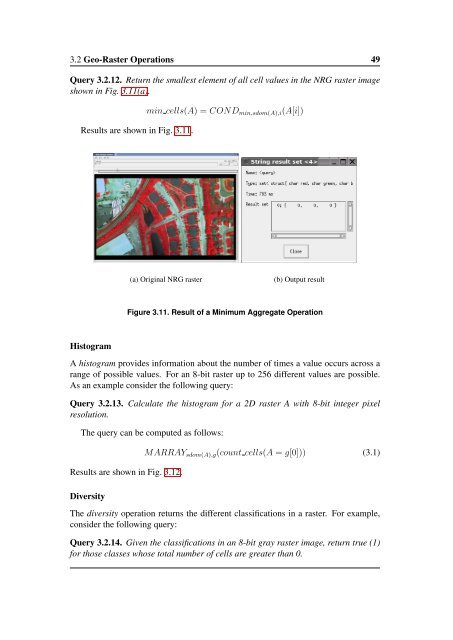Applying OLAP Pre-Aggregation Techniques to ... - Jacobs University
Applying OLAP Pre-Aggregation Techniques to ... - Jacobs University
Applying OLAP Pre-Aggregation Techniques to ... - Jacobs University
You also want an ePaper? Increase the reach of your titles
YUMPU automatically turns print PDFs into web optimized ePapers that Google loves.
3.2 Geo-Raster Operations 49<br />
Query 3.2.12. Return the smallest element of all cell values in the NRG raster image<br />
shown in Fig. 3.11(a).<br />
Results are shown in Fig. 3.11.<br />
min cells(A) = COND min,sdom(A),i (A[i])<br />
(a) Original NRG raster<br />
(b) Output result<br />
Figure 3.11. Result of a Minimum Aggregate Operation<br />
His<strong>to</strong>gram<br />
A his<strong>to</strong>gram provides information about the number of times a value occurs across a<br />
range of possible values. For an 8-bit raster up <strong>to</strong> 256 different values are possible.<br />
As an example consider the following query:<br />
Query 3.2.13. Calculate the his<strong>to</strong>gram for a 2D raster A with 8-bit integer pixel<br />
resolution.<br />
The query can be computed as follows:<br />
Results are shown in Fig. 3.12.<br />
Diversity<br />
MARRAY sdom(A),g (count cells(A = g[0])) (3.1)<br />
The diversity operation returns the different classifications in a raster. For example,<br />
consider the following query:<br />
Query 3.2.14. Given the classifications in an 8-bit gray raster image, return true (1)<br />
for those classes whose <strong>to</strong>tal number of cells are greater than 0.
















